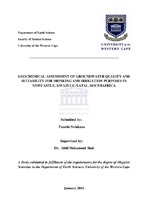| dc.description.abstract | Groundwater is one of the most valuable natural resources on earth and it forms an important part of the total water resources of South Africa. For this reason, this resource should be monitored and controlled on a regular basis. The study was conducted in Newcastle, in the KwaZulu-Natal province of South Africa. The aim of this study was to assess groundwater quality geochemically and determine its suitability for domestic and irrigation purposes. For the purpose of this study 31 samples were collected from 31 boreholes in and around the town of Newcastle. The samples were analysed for Magnesium (Mg2+), Calcium (Ca2+), Sodium (Na+), Potassium (K+), Chloride (Cl-), Sulfate (SO42-), Bicarbonate (HCO3-), Nitrate (NO3-), Fluoride (F-) (pH, TDS and Ec. The SAQWG (DWAF, 1996) and the WHO (2011) water standards were used as the basis of evaluating the suitability of groundwater for drinking purposes. For irrigation, Electrical Conductivity (EC), Sodium Percent (Na %), Sodium Adsorption Ratio (SAR), Residual Sodium Carbonate (RSC), Kelly’s Ratio (KR), Magnesium Ratio (MR) and Permeability Index (PI) were used to evaluate suitability. Classical hydro-chemical methods together with multivariate statistical methods were used to further understand the composition controlling processes. Lastly, the spatial distribution of the results was presented using ArcGIS. The results showed that the groundwater is alkaline in nature and that most of the samples are within the permissible range of both SAWQG (DWAF, 1996) and WHO (2011). Few samples showed concentration of Na+, Cl-, SO42- , F- and TDS above the guideline value as per WHO (2011) standards. The order of abundance of major ions in the groundwater, based on their mean values is as follows: Na+>Ca2+>Mg2+>K+ and HCO3->SO42- >Cl->NO3-. Classical hydro-chemical methods revealed four hydro-chemical facies in the study area, which are Ca-Mg-HCO3, Na-HCO3, Ca-Na-SO4-HCO3 and Na-Cl. The major ion chemistry analysis revealed that the main composition controlling processes in the study area is rock-water interaction. It further revealed that the ionic concentration is due to silicate weathering, carbonate weathering, cation exchange, gypsum dissolution and halite dissolution. Factor analysis indicated three factors, which explained 79.71 % of the total variance in the water quality data. The first factor which accounted for the highest variance in the data was the Alkalinity factor, followed by the Hardness factor and the Anthropogenic factor which accounted for the least variance. The cluster analysis revealed five clusters and discriminant analysis showed that Na+, TH, HCO3- and SO42- discriminate these clusters by 96.8%. In conclusion, the study revealed that the groundwater in most of the boreholes in the study area is generally suitable for drinking and irrigation. This is with exception to boreholes 13 and 31 which showed concentrations higher than the permitted level by WHO (2011) standards of TDS, Na+, Cl-, SO42- and F-. Similarly, 45.16% the groundwater samples showed that the groundwater has high sodium hazard potential which makes water from these boreholes unsuitable for irrigation purposes without proper treatment. accounted for the least variance. The cluster analysis revealed five clusters and discriminant analysis showed that Na+, TH, HCO3- and SO42- discriminate these clusters by 96.8%. accounted for the least variance. The cluster analysis revealed five clusters and discriminant analysis showed that Na+, TH, HCO3- and SO42- discriminate these clusters by 96.8%.In conclusion, the study revealed that the groundwater in most of the boreholes in the study area is generally suitable for drinking and irrigation. This is with exception to boreholes 13 and 31 which showed concentrations higher than the permitted level by WHO (2011) standards of TDS, Na+, Cl-, SO42- and F-. Similarly, 45.16% the groundwater samples showed that the groundwater has high sodium hazard potential which makes water from these boreholes unsuitable for irrigation purposes without proper treatment. | en_US |

